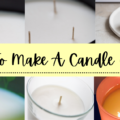Vibrant and aromatic candles are what sets the mood for a romantic dinner or a relaxing home. They can be both made using synthetic or natural materials which are easily available. Candles made from synthetic materials often give off chemicals that may not be good for us. Thus, going all-natural and toxic-free with these homemade natural candles is the safest and will give you the most enjoyable candle making experience.
- STEP 1: Prepare the Tools and Equipment
- STEP 2: Choose the Appropriate Wick for Your Candles
- STEP 3: Choose Your Preferred Candle Wax
- STEP 4: Incorporate Essential Oils Naturally Sourced from Plants
- STEP 5: Measure the Amount of Wax for Your Container
- STEP 6: Attach the Wick to the Container
- STEP 7: Melt the Wax Using a Double Boiler
- STEP 8: Mix Essential Oils to the Melted Wax
- STEP 9: Color Your Candles Using Natural Dyes
- STEP 10: Pour the Melted Wax into the Container
- STEP 11: Smoothen the Candle’s Top Surface (Optional)
- STEP 12: Remove the Candle from the Container
- STEP 13: Perfecting Your Natural Candles
- Conclusion
STEP 1: Prepare the Tools and Equipment

Here are the tools and equipment needed in creating homemade natural candles.
Containers like used or newly bought jars, pots, cups, or mugs will serve as your mold in producing candles. A smaller-sized glass container is also a good choice compared to the bigger one to prevent the container from overheating. Honestly, any container that is non-flammable and can withstand heat for a period of time can be your candle container.
If you are producing free-standing candles, you’ll also need a candle mold. A wick sticker, glue gun, or tape will keep the wick in place and attached to the bottom of the container. It also helps the wick not to bend when pouring hot wax.
Use a double boiler to melt your wax. Moisture may result in white spots in the candle. After melting your wax, you’ll need a pouring pot with a spout for dripless pouring of the melted wax into the container. This equipment is safe to use and avoids moisture from mixing with the wax.
Prepare a stirring rod for stirring the melting wax on the boiler and mixing dyes and fragrances. Chopsticks, pencils, or straw will hold the wick inside the container while pouring the hot wax.
A thermometer will monitor the heating temperature and know the right pour temperature for the wax and the temperature to add the fragrances and dyes. Measure the exact amount of ingredients such as wax, dyes, and fragrances using a scale.
Layout newspaper or parchment paper on your working table to catch spills of molten wax when pouring. This way, you won’t have a hard time cleaning your area. Lastly, prepare scissors for trimming your wick and opening ingredient packages.
STEP 2: Choose the Appropriate Wick for Your Candles

The most eco-friendly and non-toxic candle wicks you can choose are cotton, hemp, and wooden wicks.
Cotton wicks are more common than wooden wicks. They are easy to light and relight and are less likely to extinguish with a strong wind than other wicks. However, they tend to mushroom. Cotton wicks produce carbon buildup that causes the wick to mushroom at the end.
Hemp wicks are wicks coated with beeswax, which burns slower and hotter. Plus, it burns for a long time too. Hemp wicks have a rigid composition of thick, long, and very waxy bodies.
Wooden wicks give off a wonderful crackling sound when lit. Think of it as lighting up a fireplace. These 100% all-natural wicks are the perfect choice for your non-toxic candles. Furthermore, these wicks burn cleaner and produce little ashes at the tip of the wick when burnt.
This natural wick heats wax more evenly and results in the even burning of candles. Wood wicks are the perfect choice for wider candles that provide better scent throw and are more sustainable than cotton wicks.
STEP 3: Choose Your Preferred Candle Wax

Here are the healthiest and all-natural waxes to use for your candles.
Soy wax is one of the leading candle making wax in the market. It does not have much fragrance and burns slowly and cleanly. Plus, it comes at an affordable price due to its sustainability. Soy wax is colorless and is highly recommended for pastel-colored candles.
Beeswax has a genuine, sweet fragrance and is a good choice for naturally-scented candles. It is smokeless, sootless, and helps purify the air. Its higher melting point helps the candle burn cleanly without soot.
Palm wax is an eco-friendly wax with a creamy white color. It is more expensive than other natural waxes and features a wonderful scent throw.
Rapeseed wax is a newly introduced candle wax sourced from a flowering plant from the mustard or cabbage family. It has incredible fragrance retention and a great scent throw and burn time.
STEP 4: Incorporate Essential Oils Naturally Sourced from Plants

In choosing essential oils for your natural candles, choose a strong scent that lasts a long time. Essential oils smell less strongly than synthetic fragrances, so you can add more to make the scent more evident in the candle.
The recommended proportions are two teaspoons of essential oils for every four ounces of melted wax. This amount gives six percent dilution, which is considered the optimal amount for scented candles.
Here are some scent recommendations for your natural candles. Camphorous scents such as eucalyptus, pine, or tea tree give off a pungent and sharp smell. Citrus scents of grapefruit, lemon, lime, and sweet orange will give you a fresh and crisp smell.
For floral scents, you can try jasmine, lavender, and rose. We also have herbal scents coming from basil, marjoram, rosemary, and sage. If herbs are too strong for you, there are these mint scents of peppermint and spearmint with a cool and fresh smell.
Bring the feel of the forest inside your house with these woodsy scents of cedar, cypress, and sandalwood, which delivers a freshly cut wood smell.
You can also mix and match essential oils. Some oils have a weak smell, and you can power them up by combining them with other scents. You may also add organic items in your candle like plant clippings from Christmas trees or real herbs of lavender, rosemary, or any scents you like. It would be better if they were the same as the essential oil you used.
STEP 5: Measure the Amount of Wax for Your Container
Use a weighing scale to measure the amount of wax you’ll use. Four cups of wax can make one large candle, sized four by four inches or three smaller candles, sized two to three by four inches.
Another way is to measure your container’s volume. For every one fluid ounce your container holds, you’ll need an ounce of wax. After measuring your wax, prepare the candle containers. Ensure the containers are clean and dry, as moisture may result in wet spots on the candle.
STEP 6: Attach the Wick to the Container

Cut a length of wick the same height as your container. Then, add an inch to the size. This will be the wick to be trimmed later on if it is too long to burn. Dip one end of the wick into the melted wax. Then, insert and attach it at the center bottom part of the container.
Secure the wick using a chopstick or clothespin. Wrap the other end of the wick around the chopstick and let it lay vertically at the top of the container’s mouth. The chopstick ensures that the wick won’t move or dislocate when pouring the melted wax into the container. It also keeps the wick centered and stabilized, so the candle burns evenly.
Use more than one wick for a wider container. Place two or three evenly spaced wicks on the candle to help the candle burn at an equal pace on all sides.
STEP 7: Melt the Wax Using a Double Boiler
Heat the wax over medium heat using a double boiler. Melt the wax for 10 to 15 minutes while stirring it using a stirring rod. Then, use a thermometer to ensure the wax will not overheat (beeswax and soy wax combusts at 200 degrees Fahrenheit).
Here are the melting points of some waxes to guide you. Soy wax melts at around 120 to 180 degrees Fahrenheit, beeswax at 143 to 149 degrees Fahrenheit, and palm wax at roughly 179 degrees Fahrenheit.
STEP 8: Mix Essential Oils to the Melted Wax
Add the essential oils at the right temperature. Too hot of wax would destroy your oil’s active compounds and will also dampen the scent. Too cool of wax will not let the oils properly disperse in the candle.
The ideal temperature to add essential oils is between 175-185 degrees Fahrenheit. After removing the wax from heat, wait until it’s at the correct temperature before pouring in your essential oils. Use your thermometer to ensure that you are pouring at the appropriate temperature. Oils can also be added after pouring the wax into the container.
Here are the recommended temperatures relative to the wax used. Add essential oils to the melted wax when they have cooled down to the following temperature:
- Soy wax – 140 degrees Fahrenheit
- Beeswax – 160-165 degrees Fahrenheit
- Palm wax – 180-210 degrees Fahrenheit
The recommended amount of essential oils is an ounce of fragrance per pound of wax. Pure essential oils have considerably weaker scents than synthetic fragrances, so this proportion would not work the same for all oils. You can experiment with different amounts of oils to perfect the scent you want.
Remember that oils smell stronger in the melted wax and will lessen when burned in the candle. So for a container measuring two to three inches in height, you can add 20 drops of essential oils. Stir the mixture to blend well and let the oils and scents be evenly distributed throughout the candle’s height.
STEP 9: Color Your Candles Using Natural Dyes

Natural dyes are pigments extracted from plants and minerals. These are sourced naturally and not man-made. It is highly suitable for natural waxes like soy wax, beeswax, and palm wax.
Here are the easy steps in making natural dyes. Prepare the plants you will use. It can be anything from roots, stems, leaves, stamens, flowers, or a combination of these. Cut them into small pieces to easily extract color from the plants.
Put the cut pieces in a heat-resistant tea bag. Secure them with a tie or a piece of the wick to close them. Then, lower the sachet into the melted wax. The color from the plants will diffuse into the melted wax.
Let the plants seep. Wait for your desired color to come out of the wax. Remember that colors won’t come out immediately as compared to using synthetic dyes. Also, note that some plants produce pastel colors, and some have really strong colors, so you need to choose the appropriate plant to get your desired dye.
Stir the wax every two to three hours to ensure an even color spread throughout the candle. Furthermore, keep the wax’s temperature balanced throughout the coloring process so the dyes will mix well, and the wax will not solidify quickly. The recommended wax temperature when putting natural dyes should be at 130-140 degrees Fahrenheit.
Once you get your desired color, remove any plant material (small pieces that escaped through the tea sachet) mixed into the wax before pouring it into the container. These small pieces may rot and smell within the candle if not removed.
For dried or powdered plants, just put them into a coffee filter sachet and dip them in your melted wax. Do not make it a paste by adding water.
Here are some color dye recommendations and the plants you can extract for these colors. Chamomile flowers and vanilla pods with a beige-brown to light brown tone are perfect for beige or pastel-colored candles. There is also the madder root that produces delightful pale peach color.
Annatto seeds produce rich yellow to yellow-orange color, while turmeric when used fresh and cut into small pieces, will give you a rich yellow color. Use safflower’s petals for yellow dye and saffron’s stamen for a warm yellow color. We also have the lemon peel, which shows a vivid, almost pastel yellow color.
If you want a fire red candle, sliced, chopped, powdered, or dried root alkanet root gives a rich red tone. For orange tones, use paprika, orange peel or zest, and carrots. Dark-colored rosehips (not the green ones) will also give your candle a reddish-brown tone.
Whole cloves crushed are what you can extract if you want a vibrant brown-colored candle and cinnamon for a light brown color.
For refreshing blue tones, indigo would be a great choice. It is known for dyeing fabrics and produces rich cornflower blue. For pastel blue dye, just seep indigo into the wax for a shorter period.
Lastly, for the colors of nature, you can use these greens. Spirulina will give you a vivid sea green shade while nettles give amazing olive color. Kelp, parsley, rosemary, and wheatgrass would also bring out bright green tones to your candles.
STEP 10: Pour the Melted Wax into the Container

Preheat the container before pouring the wax. Doing so slows down the wax’s normal cooling time. When the wax cools quickly, it shrinks, deforms, and leaves spaces at the container’s side (also called wet spots).
Pour the wax into the container. Leave an inch room for the wick to burn, avoiding the wick and the chopsticks when pouring. Pour slowly to prevent air bubbles from surfacing. These air bubbles make the candle’s finished surface look uneven and undesirable to the sight.
Incorporate real herbs into your candle. These herbs can be pressed in the container’s side and will harden together with the wax bringing a more authentic scent to your candles. Sprinkle bits of these herbs and mix them in the melted wax.
Here are some recommended pour temperatures relative to the wax used:
- Soy wax – 120-165 degrees Fahrenheit
- Beeswax – 155-160 degrees Fahrenheit
- Palm wax – 185-195 degrees Fahrenheit
After pouring and putting on essential oils, let the wax cool and harden. Let your candle solidify for 30 minutes to an hour and cool overnight. Do not light it immediately as it needs 24 hours or more curing time before burning.
STEP 11: Smoothen the Candle’s Top Surface (Optional)
When the candle hardens, the top surface would sometimes become concave and not have a smooth surface. An uneven candle top would contribute to the candle’s uneven burning, so it should be addressed right before your first burning of candles.
Smoothen candle tops with these simple instructions. Reheat the remaining melted wax using a double boiler. Then, wait for the correct pour temperature of the wax before pouring it at the top of the already hardened candle.
Tap the candle container a little on the table to release air bubbles trapped in the poured wax. This action evens out the top surface of the candle. Since you are pouring additional wax on your container, always remember to leave enough room for the wick to burn. Trim wick at ¼ to ⅛ inch in size for the best burning experience.
STEP 12: Remove the Candle from the Container
Unwrap the wick from the chopstick or clothespin. Then trim the wick to ⅛ inch for soy candles and ¼ of an inch for wood wicks. Trimming properly sized wicks help reduce the production of smoke and soot.
Carefully remove the candle from the container (for free-standing candles only). Finally, test-burn your candle. The first burn should be for three straight hours as this determines if the candle burns evenly throughout its whole height.
STEP 13: Perfecting Your Natural Candles

Here are some tips for creating the perfect natural candles at home.
Keep your candle scent from fading. Cover it with a lid when not used to make the scent stay in the candle and not easily diffuse to the air. You can also refresh your candle scents by melting the candle then putting additional essential oils on it.
Put the candle in the freezer (for container candle), then wait for it to shrink and easily slip out of the container. Then, melt the whole candle in the double boiler, following the same melting temperature stated above.
When the candle has completely molten, remove the wick. Then, add more essential oils before pouring them back into their container or mold.
Use the correct size of wick for your candle. Bigger wicks produce larger and taller flames with excessive heat. When this happens, the candle provides more wax to the flame than it can handle, causing the candle not to burn evenly. As a result, the wick will tend to mushroom.
Candle mushrooming can break down the candle’s fragrance which results in a poor hot throw. To prevent this, regularly trim wicks after three hours of burning.
The candle wick should not be lit for more than four hours. If you allow this, the candle may overheat and produce carbon buildup, causing wick mushrooming.
Do not put excessive oils. This action may cause the oils to pool at the bottom of the container as excess oils do not blend well with wax. Remember to put just the recommended amount of essential oils. You can also experiment with different amounts for your preferred scent strength.
Stir the wax with the essential oils for two continuous minutes. This will ensure a well-balanced distribution of scent throughout the candle.
White frosting in soy wax candles is a common concern with soy wax candles and other vegetable waxes. It is the natural occurrence of tiny crystals on the top and sides of the candle. To minimize white frostings, always follow the correct pour temperature. Avoid excessive stirring. Just stir slowly, as doing the opposite can also cause white frostings on your candle.
Another good way to prevent white frostings is preventing the wax from cooling too quickly. You can preheat your container in an oven, set at 100 degrees Fahrenheit, so the wax would not dry quickly and leave some undesirable white issues.
Little scent throw happens when you apply a small amount of fragrance or use poor quality or not pure essential oils. This may also happen when the essential oil is not added to the correct temperature and does not blend well with the wax.
To fix this, follow the recommended temperature for essential oils. Add more fragrance to your candles. Essential oils have weaker scents than other fragrances, so adding a ten percent fragrance ensures an optimal scent throw. Furthermore, provide enough curing time of not less than 24 hours before you test-burn the candle.
Smoke and soot when burning candles may be a result of using heavy dyes and fragrances. Apply just the right amount for all essential oils and color dyes to avoid this mistake. Also, use the appropriate size of wick. Large wicks burn candles unevenly and produce bigger flames resulting in carbon buildup and excessive smoke and soot.
Place candles away from draft areas. Draft areas may cause candles to burn quicker and produce excessive soot and smoke.
A candle that does not burn evenly is a common problem in candle making. This happens when the wax melts unevenly when lit. Prevent this from happening by keeping the candles away from draft areas.
Make sure that the candle wick is centered before pouring the wax. An uncentered wick also causes candles to burn weirdly. Also, it needs to be the right size, not bigger, and not too small so that the wick can burn the candle wax well.
Don’t expose the candle to direct sunlight. Direct sunlight causes color fading of candles as natural dyes fade faster than synthetic ones. Use more natural dyes for stronger colors and less for lighter ones.
Store candles in a dark area and keep them away from interior lighting. A UV inhibitor would be great to prolong the candle’s color and protect it from turning yellowish.
I wrote a detailed article on the common mistakes in candle making and all the solutions to produce perfect candles. You can visit the article here.
Conclusion
After undergoing the above steps, you are now ready to burn your homemade natural candles. You would definitely enjoy using these candles as they are made with maximum effort and composed of all-natural and non-toxic materials, giving your home a relaxing and fresh ambiance. It would be another romantic dinner and date night with these beautifully-made natural candles.















